|

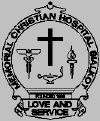
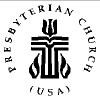
1998 Balochistan Field Health Survey
Final Report
by Rev. Mark Southard
May 10, 1999
(This report is also available in its original format
[WordPerfect].
To download that document click here.
Christian Hospital Quetta
Quetta, Pakistan
1998 Balochistan Field Health Survey
Final Report
"The Spirit of the Lord is upon Me,
Because He has anointed Me
To preach the good news to the poor
He has sent Me to heal the brokenhearted
To proclaim liberty to the captives
And recovery of sight to the blind,
To set at liberty those who are oppressed"
--Luke 4:18
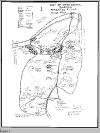
|
Sorgaz Union Council
Mastung District, Pakistan
Map prepared by Dr. M. Ismail
Medical Officer for Sorgaz Union Council
Killis (villages) surveyed indicated by shading. |
|
|
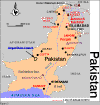
|
Map of Pakistan
(Sorgaz Union Council indicated)
|
© copyright Rev. Mark Southard, 1999
All rights reserved.
No part of this publication may be reproduced or transmitted, in any form or by any means,
electronic or mechanical, including photocopy, recording, or any information, storage and
retrieval system, without permission in writing from the publisher.
Acknowledgment is made to the many people who have assisted in the 1998 Balochistan Field
Health Survey. Special thanks is due to the Field Staff and Leadership Staff who made this survey
possible.
Published by:
Christian Hospital Quetta
Mission Road
Quetta, Pakistan
This report is dedicated to the people of Sorgaz Union
Council who, with great hospitality and grace, opened
their homes and hearts to share what they and their
forebears have practiced and learned from a life lived
close to the soil of the earth. It is offered to the
service of the people of Balochistan, and to the nation
of Pakistan, in the hope that through such active
listening the dreams of the people for healing,
wholeness, and community might grow and flourish.
1998 Balochistan Field Health Survey
IMPLEMENTING AGENCY:
Christian Hospital Extension Programme (CHEP)
Christian Hospital Quetta
Dr. Sadrak Jalal, Director
Quetta, Pakistan
92-81-842697 phone
92-81-822160 fax
[email protected]
DIRECTED BY :
Rural Health Care Project (RHCP)
Dr. Emmanuel I. Bhatti, Superintendent
Memorial Christian Hospital Sialkot
Paris Road, Sialkot-1, Pakistan
92-43-226-5868
92-43-226-3487 alt. phone
92-43-226-5869 fax
[email protected]
FIELD OPERATIONS COORDINATED BY:
Mr. Tabasum Parvez, Principal
School of Nursing
Christian Hospital Quetta
Quetta, Pakistan
CONSULTATION BY :
Presbyterian Church (USA)
Rev. Mark Southard, Director of People Group Networks
Presbyterian Frontier Fellowship
826 N. Clewell St.
Bethlehem, PA 18015-2533
1-610-861-9454 phone
[email protected]
Contents
Introduction
Administration
Purpose and Objectives
Survey Design
Staff
Job Descriptions
Interview Methods and Principles
Data
Data Recording Instruments
Cleaning and Tabulation of Data
Analysis
Demographic and Socio-Economic
Health Concerns
Health Seeking Behavior and Rationale
Recommendations
Introduction
National health surveys have been conducted in Pakistan which include quantitative data
on health conditions and services in Balochistan. Qualitative surveys have been few in number
and have not dealt adequately with the particular environmental, cultural, socio-economic and
religious factors related to health seeking behavior and healing in this particular region. Adequate
knowledge of and consideration of such factors is essential for proper planning and development
of health services generally, and particularly in such a richly plural healing system environment.
The 1998 Balochistan Field Health Survey was initiated by Dr. Sadrak Jalal, Director of
the Quetta Christian Hospital, Quetta, Pakistan in August of 1997 as a means of determining how
best to plan for and develop patient-sensitive high-quality health services in the service area of the
Christian Hospital Quetta's Mastung Road Clinic. Christian Hospital Quetta is a hospital of the
Diocese of Karachi, Church of Pakistan. The Presbyterian Church (USA) , an international
partner organization of the Church of Pakistan, provided consultation and funding for this
research project.
The Rural Health Care Project (RHCP), Sialkot, Pakistan, provided field direction for the
facilitation of the survey. RHCP regularly carries out field health surveys throughout Pakistan
and is a national leader in Community Health and Development. RHCP is a programme of the
Memorial Christian Hospital Sialkot which is a member of the Christian Hospital Association
Pakistan (CHAP) along with Christian Hospital Quetta and 62 other Christian medical
institutions in Pakistan.
Administration
PURPOSE OF SURVEY:
To establish basic health statistics, including relevant cultural and socio-economic factors,
influencing health practices in the catchment area of the Christian Hospital Quetta's Mastung
Road Health Clinic through qualitative assessment of the cultural forms of health seeking
behavior, and the relationships between the plural healing systems, in order to provide reliable
strategic planning information for the development of health services appropriate to the needs,
resources, and aspirations of the people.
Particular emphasis has been given to the analysis of the data with respect to cultural and
socio-economic factors influencing health-seeking behavior as they intersect with the felt needs
and goals of the local population.
OBJECTIVES:
- Contribution to the health statistics information database of Pakistan, particularly for the
province of Balochistan
- Ethnography of health-seeking behavior and healing practices in a demographic sample
representative generally of the Kalat Plateau of Balochistan
- Marketing and strategic planning instrument for the catchment area of the Christian
Hospital Quetta's Mastung Road Health Clinic
- Community organizing and active promotion of community health and healing in the
Mastung Road area
TYPE OF SURVEY: Focus Group Qualitative
Survey Design
Design of the Sample
The sample population of the 1998 Balochistan Field Health Survey consists of the
catchment area of the Mastung Road Clinic (MRC) of the Christian Hospital Quetta. The MRC is
located almost in the center of the Sorgaz Union Council (UC), the northernmost political unit
within the District of Mastung, Balochistan. 45 kms south from the Capital city of Quetta, after
crossing over the steep Lak Pass, Sorgaz UC is the first settlement at the northern end of the
Kalat Plateau. It is bounded on three sides (N, E, &W) by massive mountains, impassible by
conventional transportation. 15 kms to the south lies the considerably more populated Mastung
City, and then the rest of the Kalat Plateau stretching to Khuzdar some 300 kms distant. Sorgaz
UC is typical linguistically and culturally of the settlements dominating the Kalat Plateau. The
mother tongue and culture is Brahui. As a unit of analysis it could be considered to be
representative of the entire Kalat Plateau.
Initial consultation with various leaders of the health sector of Pakistan aided in the design
of the sample. Col. Dr. Mohammed Ayub Khan, one of the Directors of the 1988-95 Pakistan
National Health Survey, Dr. Tasleem Ahktar of Pakistan Medical Research Council, Dr. Tauseef
Ahmed of the World Bank, Megan Douthwaite of The Population Council, Dr. Shafi Muhammad
Zehri, Secretary Health Department Govt. of Balochistan, and Dr. Bashir Ahmed Baloch, District
Health Officer Mastung all contributed greatly to the development of the survey design.
Further consultation with Dr. Ismail, Medical Officer of Sorgaz UC, and with Haji
Sahb,
Sardar of the Mastung Road Killi (village) resulted in a meeting with approximately 18 of the
leaders of five of the Killis (villages) nearest to the MRC. This meeting introduced these leaders
to the method and purpose of the survey through dialogue and a sample demonstration of the
survey. Full and enthusiastic cooperation resulted. It was agreed that the survey should be done
in as many of the killis in the Sorgaz UC as possible. Nine killis were selected and 27 households
(3 each) were identified in which to conduct focus group interviews.
Sampling Frame and selection of Primary Sampling Units (PSUs)
The sampling frame consisted of the 9 killis in closest proximity to the MRC in the Sorgaz
Union Council. Primary Sample Units were these nine killis:
Mastung Road
Hazar Khan
Terri Rek
Terri I
Terri II
Kandawa
Koshkak
Sungar
Purdul
Selection of Secondary Sampling Units (SSUs)
Secondary Sample Units were the households within the killis, a household being defined
as all those individuals sharing a common kitchen. Three households were interviewed in each
killi with separate focus group interviews for females and males.
Dr. Ismail, Haji Sahb visited the killis and arranged appointments through the Lady Health
Workers (LHW) of each killi for survey interviews with the Secondary Sample Unit households.
Sample Size and its Allocation
Total population of the Sorgaz UC is approximately 21,500. Population of the sampling
frame (the nine killis) is approximately 5,100 (24% of total). The survey sample included 27
households in 51 interviews with 265 respondents (183 female), or approximately 5% of the
sampling frame population. Within the 9 households there are 137 adults age 18+. Therefore, it
can be assumed that on average each interview was comprised of 50% non-household guests.
There were an average of 5.20 respondents per interview, median of 4. The average for female
interviews is 6.77, and male is 3.42. Median for female interviews is 6, and male is 3.
Non-respondents
Participation in the survey was high. On the very first day of interviews there was a
miscommunication which resulted in the male interviews of that killi being missed. Otherwise, as
indicated by the attraction of 50% non-household guests, attendance and cooperation was
enthusiastic. The full endorsement of the survey by the Sardars (village leaders) of the killis was a
very significant contribution to a high level of participation. In addition, the excellent work of the
survey team resulted in very good community relations.
Staff
Leadership Staff:
Dr. Sadrak Jalal
Project Coordinator
Dr. Emmanuel I. Bhatti
Project Director
Mr. Tabasum Parvez
Field Operations Coordinator
Rev. Mark Southard
Social Science Research Consultant
Mr. Handery Masih
Male Field Coordinator
Ms. Sheba Cecelia David
Female Field Coordinator
Field Staff:
Nine (9) Male Interviewers and nine (9)
Female Interviewers served as primary field
workers:
Naseema Baloch, Facilitator
Nazia Baluch, Recorder
Fazia Faiz, Facilitator
Shazia Faiz, Facilitator
Zeenat Gul, Recorder
Humaira Mengal, Recorder
Shakoor Ahmed, Facilitator
Ghulam Nabi Baluch, Recorder
Naveed John, Recorder
Nadir Masih, Facilitator
Qadir Masih, Recorder
Muhammed Qasim, Facilitator
Kamran Bhatti, Observer
Javed Khurshid, Observer
William Chaman, Observer
Tariq Masih, Logistics Assistant
Noel, Driver
And the Lady Health Workers of each killi
Job Descriptions
Interview Team:: the team of three interviewers (Facilitator, Recorder, and Observer) of the
same gender are responsible for conducting individual interviews with household groups of the
same sex.
Male and Female Field Coordinator:: to manage the Interview Teams and maintain
quality control in operations by fulfilling the following duties:
- assign Interview Teams to their daily responsibilities
- monitor actual interviews, providing guidance and problem solving as needed
- collect/collate Interview Report Forms and tape recordings immediately following each
interview
- translate and facilitate daily Interview Team debriefings
- liaison with the Leadership Staff to achieve survey goals
Facilitator: to lead the Interview Team and conduct the interview in the collection of
qualitative data by fulfilling the following duties:
- represent the Interview Team to the leader and other members, of the same sex, within the
household being interviewed
- facilitate the actual interview discussion through questions and encouragement of the
respondents
- maintain discipline within the Interview Team at all times to assure task completion
- extend thanks for their participation to the household on behalf of the Christian Hospital
Quetta
Recorder: to record the interview event by fulfilling the following duties:
- complete an Interview Report Form during the actual interview
- faithfully and honestly report the most important information to the Leadership Staff
during the follow-up debriefing
Observer: to support the Interview Team by fulfilling the following duties:
- report observations and non-verbal feedback from the interview
- attend to any unforeseen needs which occur during the actual interview
Interview Methods
Each interview lasted approximately two (2) hours and consisted of four half-hour periods
covering the following elements:
First 30 minutes Hospitality, introductions and often chai (tea)
Second Question #1 - What are the health concerns of your family and community
Third Question #2 - What are you doing to address these concerns
Fourth Question #3 - What is the rationale for your health seeking behavior
First Period
Interviewers and respondents were seated on the ground in a circle, ordinarily in the guest room
of the household or killi. Time was taken to establish rapport with the respondents during this
period of introductions and chai.
Second Period
The Facilitator would begin the second period with a brief explanation of the purpose and process
of the interview. A modified form of Participatory Rural Assessment (PRA) technique was used
to enhance the interview method. When the first question was asked the Facilitator would place a
round cloth, embroidered in the local style, in the center of the group/circle. The cloth signified
the community. Blank cards were distributed to the participants. The Facilitator would one by
one ask respondents for their card, and then write on the card the respondent's health concerns,
and then place the card at the edge of the round embroidered cloth. This would be repeated until
all respondents had an opportunity to share. The Facilitator would then inquire about the
responses in order to determine rates of occurrence and the relative priority of the concerns.
Rates and priorities were written in the corners of the response cards.
Third Period
Based upon the responses in the second unit follow-up questions would then be asked in order to
determine health seeking behaviors associated with particular concerns.
Fourth Period
Further follow-up would probe to identify what factors influenced health seeking behavior. What
conditions and perspectives of tradition, economy, education, severity, faith, gender, and
practicality (proximity, availability, etc.) constrained or directed such choices.
Focus Group Principles
- The goal of a Focus Group is to respectfully listen to the ideas, values and experiences of
a group of people in order to faithfully record them in words and concepts which are as
close as possible to those of the actual respondents.
- Listen, and ask people to tell you more.
- Focus Groups are not occasions to teach or to give information to the respondents.
- The result of a Focus Group is successful when the interviewer reports back briefly what
they have heard, and the respondents reply, "Yes, you have heard what we are saying".
- The respondent is never wrong.
- If you don't write it down how can you remember what was said? Use your recording
instruments.
Recording Instruments
Respondent Feedback:
Interview Instrument
Participatory Cards
Two means were used to record respondent feedback. The first means was an interview
instrument which Recorders used during and after the interview to register respondents' feedback.
The second means of collecting responses was the use of cards which the Facilitator handed out
to respondents and then collected and placed at the edge of the cloth in order to collect feedback
through a participatory group process.
The interview instrument had three sections which corresponded to the three half hour periods of
the interview, and a cover section which was used for administrative purposes in managing the
records. The first of the three sections listed 105 of the major epidemiological diseases/concerns
and provided extra space for "other" concerns. Beside each listing a box was provided to register
the occurrence rates mentioned by the respondents during the interview. Diseases were
categorized into five areas: Infant/Children, Female/Maternal, Adult, Men, and Community.
The second section of the interview instrument was used to record health seeking behavior with
respect to practitioner/treatment choice. This consisted of a listing of the various practitioners
and treatments available in the region with tick boxes alongside so that the recorder could
enumerate the order of use for specific disease treatments.
The third section of the interview instrument provided a listing of various practitioners with open
space alongside in which the Recorder could register the rationale for pursuing a particular course
of treatment or practitioner.
Ample open space was provided throughout the interview instrument for recording qualitative
feedback, quotations, and general observations. Interviewers were trained and encouraged to
listen actively in order to faithfully record the feedback of the respondents.
The use of the cards was previously explained in the description of the Interview Process. At the
end of each interview the Facilitator and the Recorder would consult and assure that the interview
instrument was properly and fully completed. Both had to sign off on the cover sheet, along with
the respective Field Coordinator, attesting to the accuracy of the record.
Demographic Data
Lady Health Workers
Lady Health Workers (LHW) in each of the killis met with Dr. Ismail, the Medical Officer of the
local Pringabad Basic Health Unit (BHU) and completed demographic inventories for each
household which was interviewed. This data included Head of Household, Head of Family, family
members, gender, age, education, occupation, and relationship to Head of Household and to Head
of Family. In one killi no LHW has been trained due to the seasonal residency of the population.
Therefore demographic data for that particular killi is not included.
Cleaning and Tabulation of Data
Field checking of data was the responsibility of the Male and Female Field Coordinators. After
each interview they collected the interview instruments and cards to review them for
misunderstandings, clarifications, and completeness. Corrections were made immediately in the
field.
During the week following the field operations a complete translation from Urdu into English of
all the interview instruments, cards, and qualitative data was completed. The originals and the
translations were then delivered to Mark Southard. Cross-checks were done to verify correct
identification of households according to the separate groupings by gender.
Data was then entered into EpiInfo 6.0 software program for cleaning and analysis. EpiInfo 6.0 is a
database analysis program distributed by the Center for Disease Control, Atlanta GA, USA. Where
appropriate responses were cleaned to eliminate double reporting by the male and female representatives of
the same households.
Demographic and Socio-Economic
|

Figure 3

Figure 4 |
Age distribution of Males and Females is characteristic of populations with high birth rate and low
life expectancy. There is no significant plateau to the distribution curve (figure 3) as is
characteristic of populations with long life expectancy. Rather, the curve drops precipitously
from adolescence to mid-40s.
There are two peculiar anomalies to be noted, particularly in the male population. In the 10-20
age bracket males are highly under-represented. And again in the 50-60 age bracket males are
again under-represented.
The complete absence of females in the 45-50 age bracket is also of note.
The two dips in male representation in the population results in a slight overall gender ratio in
favor of females (figure 4). |

Figure 5

Figure 6

Figure 7

Figure 8

Figure 9

Figure 10

Figure 11

Figure 12

Figure 13

Figure 14

Figure 15

Figure 16

Figure 17

Figure 18

Figure 19

Figure 20
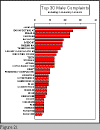
Figure 21
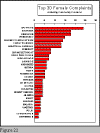
Figure 22
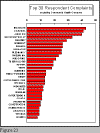
Figure 23
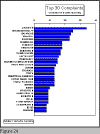
Figure 24
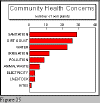
Figure 25

Figure 26 |
Occupations by Age groups for Males
The most obvious factor in male employment is the high rate of government service. At least
25% of males in all age groups are employed in some form of government service. Over 60% of
the age group from 26 to 45 years are so employed. Further information about the nature of this
work would be very helpful. What kinds of activities are involved? How frequent and regularly
do they occur? What levels of government are the employers; Federal, Provincial, local, tribal?
By signifying government service does that mean occasional work within the traditional structures
of tribal power? Is government service a category of work so irregular that it is another form of
unemployment? This is to be suspected considering the accepted figures for unemployment in
Pakistan, and especially in Balochistan, are significantly higher than the figure of 5% reported by
the respondents.
The percentage of private sector employment for adult males remains a nearly constant 29% until
the 46+ age range in which it increases to 46%. However, the types of private sector employment
change dramatically throughout these age groups. In the 26-35 age group there is a significant
decrease in the number of farmers and shopkeepers, an increase in unemployment, and the
appearance of two categories of employment (driver and private) which do not appear in any
other age groups. The categories of Teacher appear only in the 36-45 age group, and Politician
only in the 46+ age group. Shop keeping steadily increases from youngest to oldest, with the
exception again of the 26-35 age group in which it is entirely absent. These significant shifts in
occupations by age groups suggest that in the private sector there is a job mobility which relates to
age and status. Occupations by Age groups for Females
Domestic enterprise is the primary activity for females. The proportion of women holding the
role of housewife steadily increases with each age group until it reaches 100% of those 46+.
As with males, government service is a significant portion of the employment for women working
beyond and/or in addition to the home. Though a far smaller proportion of females work in
government service than men, the percentage for females in this traditional culture is very high.
The same questions which pertain to the category of government service for males apply to
females. What does government service actually signify?
What can be said with confidence is that although the vast majority of females continue holding
traditional roles with respect to domestic management, a social shift has occurred for women
under 40. This shift has brought a small but significant number of women to be identified as
holding an occupation outside of domestic duties.
Years of Education by Age groups for Males
Apart from any analysis of the data on years of education it must be noted that feedback from key
informants suggests that the education system in the area is ineffective in producing literate and
informed students. Discipline in the schools is poor. Teaching is done by "those who couldn't get
work otherwise." Facilities are neglected by the government. Proximity to the school heavily
influences rates of attendance. Most students have no expectation that education will provide
avenues of opportunity.
In the face of this bleak picture, the data shows that in terms of years of education, males have
maintained roughly comparable levels of education over the four age groups in figures 13-16.
Those attaining MA level are nearly equal in all age groups at approximately 18%. The shift of
these has been one in the 18-25 age group in which those never attending school is 30% more than
the other 3 age groups. In addition, significantly fewer in the 18-25 age group have exceeded the
level 10 in comparison to other age groups.
Overall the trend indicates a decline in the most recent generation of students completion of
school.
Years of Education by Age groups for Females
In contrast to the males, females have experienced dramatic increases in levels of education over
the past thirty years. No females 45-55 received any formal education. 17% of females 35-45
received only primary education. The dramatic shift in female education is apparent in the 25-35
age group. Those who received no formal education at all came within 20% of the males. More
significantly, females began achieving at every level up to MA, with 65% achieving at least a
primary education. The advances for females in higher levels of education continued to increase
for the 18-25 age group, with nearly 50% achieving FA levels. This increase in higher education
in the 18-25 age group is in contrast to an almost 20% increase from the 25-35
age group of
females receiving no formal education.
The trend indicates fairly stable rates of education for males with dramatic increases for females,
with the exception of a reversal in primary education, the least educated of both males and
females. This could be suggestive of disillusionment in the recent generations with respect to the
value of education for realizing good employment. It may also indicate a widening of social class
in the killi with a large lower class and upper class, with less in between.
Corresponding to the rising levels of education indicated here there is evidence from the
respondent feedback that increased education relates to an awareness of and preference to utilize
bio-medical practitioners.
The high level of employment in the government sector, and particularly the increase in female
employment in the government sector, as well as a dramatically higher level of female education
all suggest that there is an unusual degree of power sharing by the Sardars of the killis. Power
sharing of this sort is particularly significant in this conservative traditional context and suggests a
high level of opportunity for human and community development.
Health Concerns
Figures 21-24 are tabulations of respondents reports of disease occurrences per household. Male
responses and female responses were separated in figures 21 and 22 in order to present the
differing priorities and awareness of the genders. Figures 21-23 are reports of disease occurrence
rates as simple totals. Figure 24 takes account for the likelihood that since males and females
from the same household are reporting occurrences in the same household that rates are falsely
inflated, if not doubled. To correct for this double reporting, figure 24 lists the occurrence rate of
either the male or female respondents in each household, whichever is higher or equal.
Figures 21-23 do not include Community Concerns such as sanitation, water, dirt & dust,
irrigation or other factors which were reported only as singular occurrences per household. The
respondents simply as a group said "yes" or "no" to indicate that these problems were present.
Considering this difference between multiple reporting of disease occurrences versus singular
occurrences of Community Concerns, the Community Concerns are particularly prominent. For
example, just one household might report eight cases of backache, another household 3, and so
on. But Community Concerns received no more than one response per household. Therefore, the
fact that four Community Concerns (sanitation, dirt & dust, water, and irrigation) registered in the
top 30 complaints is particularly significant. As seen in figures 25-26, sanitation and dirt & dust
were concerns in over 80% of households, and water was a concern in over 75%.
A comparison of figures 21and 22 shows the different perspectives of the males and the females
with respect to disease complaints. For females, four of the top seven (7) complaints are related
to maternal health; pregnancy complications, delivery complications, family planning, and
menstruation. Diarrhea, primarily a problem in infants and children, could easily be included in
this group of concerns as Mother/Child health concerns. Backache and headaches often were
associated with the problems of women in bearing many children. One 37 year old female
responded,
"I have 7 children and if I become pregnant now I always have a miscarriage
during early pregnancy. I am very weak and often suffer from backache. At first I
was having my periods in time, but from the day I've started using the tablets of
family planning (i.e. for 3 or 4 months) I am not having them on time, for which I
am very upset and scared, because it is affecting my stomach."
For males, diseases related to environmental factors predominate; respiratory problems (3 of top
10), water related problems (malaria and diarrhea) and diet/altitude related jaundice.
"We are suffering from fever, flu, diarrhea, Malaria, and other diseases just
because of the dirt and filth which is lying in our surroundings."
Pregnancy and delivery complications are the only specifically maternal problems which appear on
the males' top 30 complaint list, and then in 9th and 16th rank. These rather low ratings are in
contrast to the emphasis placed upon them by both the males and females as high priority health
concerns.
Figure 24, which corrects for double reporting, exhibits a composition more characteristic of the
male respondents of figure 21. These health concerns commonly associated with poverty living
conditions are highly reported and could be considered chronic and endemic to the community.
The maternal health concerns which cluster between rank 12 and 20, receiving a high priority by
respondents male and female, could be considered acute and sporadic. Concerns related to
poverty living conditions are frequent but not as immediately costly as are the life threatening
complications associated with pregnancy and child birth.
Health Seeking Behavior and Rationale
Male respondent, "It depends on your belief. We believe on Maulvi, and we are
happy. But the Maulvi himself doesn't believe their own self. When his son or
daughter becomes ill he goes to the doctor."
Health seeking behavior in the survey area is in transition. Extreme plurality of healing systems,
the introduction of western bio-medicine, and the rapid transition in the socio-economic status
(especially levels of education) of the principal health care managers (women) has created an
environment of heightened comparison between the traditional systems and the more recently
introduced bio-medical system. The traditional practices of herbal medicine, faith/spiritual
healing, humoral medicine, and folk healers have always provided many options in a context of
comparison. The introduction of western bio-medicine and the education of younger females in
the most recent generation has dramatically heightened this context of comparison.
|
These traditional patterns of health seeking adopt a comparative approach in the pursuit of health
and healing. Various factors or constraints channel health seeking behavior through the range of
options. The persistence of this mixing and matching persists in the context of bio-medicine such
that bio-medicine is one of the range of options. One of the dominant perspectives which governs
the choices is a "do no harm" rationale, as exhibited by this female respondent:
"We go to the Maulvis for Dam because if we go to the doctors and take their
medicines then while taking the medicines some more diseases take over our body,
and then the doctors get confused and don't know how to treat. But in the case of
Dam nothing of this sort happens because in Dam and Tawiz we are given the holy
saying to wear and that is of no harm."
The constraints which bear on these decisions include tradition, education, finances, faith and the
perceived severity of the situation. One woman described this way,
Female respondent, "We don't go to the Mullahs, Pirs, and Syeds because our
husbands don't believe on such things, nor do we go to the doctors because we
can't afford to, though we go to the Hakims. And along with this we also use our
home made medicines. But our main problem is that we don't have a lady doctor
in our place."
It was primarily older women who shared their insights regarding traditional home healing
methods such as:
"For the treatment of stomach we take Babbar which is a wood, we boil it and
drink it. And for diarrhea we use lemons, mint and Poarchanak, and boil them and
drink it."
Recorder, "How do you come to know by yourself that your child is suffering from
Whooping Cough and start the treatment yourself?"
Respondent, "After having anything the child vomits then we come to know that
he is suffering from Whooping Cough.
And in the case of measles or small pox we take Azbotak and boil it in water and
give it to the kids and by taking this he will easy go through this and will recover
soon.
And in the case of jaundice we try our best not to give hot things to patients and
along with this we take such patients for Dam and along with this say some special
prayer on water and give it to the patients for their better recovery."
This woman's approach combines herbal and humoral healing systems. In some cases the resort
to home remedies is a necessity of economy. A Mid-wife respondent reports,
"We are very poor and can't go to the doctors. That is why we treat our own
diseases in our own traditional way."
The younger women tended exhibit a higher degree of awareness and openness to biomedicine.
Education and severity of illness are the most significant factors influencing health seekers
towards considering bio-medicine as a treatment. Among the families who almost exclusively use
bio-medicine this woman's perspective was most often held,
"Being an educated family we always go to the doctors, and whatever the doctors
recommend we take it regularly."
Interview responses indicate that the current comparison between the traditional healing practices
and recently introduced western practices is perceived in terms of belief in particular healing
systems. The expression is most often phrased as "we believe in", such as the sentiment expressed
by the male respondent above. The female respondent below echoes a common explanation of
health seeking behavior.
"At first we used to do the treatment in our traditional way but when we realized
that it is not working out we started going to the doctors.
If somebody is suffering from a pain in the waist we used to take him/her to Syed
Shahib who used to do Dam and give Tawiz to the patients of Jaundice, but if the
results are not positive then we go to the doctors.
We use traditional medicines for minor diseases like headache, fever, etc. Our
Balochi medicines are not harmful like if they are not of use then on the other hand
they will not harm your body. But in the case of doctor's medicines first of all they
are very expensive and second they force us to eat them."
In conclusion, health seeking behavior in the context of extremely plural healing systems is
undergoing a dramatic shift in which traditional treatments and bio-medicine are increasingly
polarized. There is a sense that the power of traditional treatments has diminished, while at the
same time there are not adequate provisions for bio-medical care. Nonetheless, bio-medicine is
increasingly perceived by the younger and more educated to be the highest if not the only option
for health care.
Recommendations
#1 Enhancement of the Lady Health Workers' skills and role in the community
The fundamental implication of this survey is that the emergence of a more educated young
female population is the foundation to the development of an ongoing health care service for the
Christian Hospital Quetta's Mastung Road Clinic service region. The program of Lady Health
Workers (LHW) is key to this objective. Continuation of the fine work which is being done by
Dr. Ismail is essential. Further enhancement of the Lady Health Worker program, especially
building relationships with the LHWs as a referral system to the MRC, would complement the
development of the MRC.
#2 Literacy training, especially for domestic health care providers
One key Informant identified that,
"The one problem, the greatest barrier, which blocks the development of the
community health and industry is illiteracy. This is the first priority for lasting
change. Many people go to school, but do not get an education, are not able to
read or write."
A literacy program which would train Lady Health Workers to teach literacy to the health care
providers in the households of their communities might be a first step in enhancing the LHW
position and program.
#3 Lady Doctor
The critical need for a Lady Doctor is without question the foremost felt need of the community.
The most frequently verbalized comment by respondents echoes what these women state so
clearly:
Female respondent, "We all are going through the problem that we don't have a
lady doctor nearby and we really are desperate to have one."
Female respondent, "We have full belief in doctors and we regularly visit the
doctors. The main problem is that we don't have any proper arrangements for the
ladies who all are pregnant, though there is a trained nurse living nearby, but still
there is no lady doctor over here. Plus there is no ambulance present in the case of
emergency."
Female respondent, "whenever our ladies have delivery problems, we don't have an
ambulance, a lady doctor, or hospital for them."
A lady doctor ought to be the first new staff added to the MRC. Their focus should be the
development of a Mother Child Health Care Program.
#4 Organize the Community for Preventive Health
The chronic needs of the community are mostly related to preventive health concerns.
Development of the Mastung Road Health Clinic ought to be done in close cooperation with the
preventive health programs of the Basic Health Unit, Pringabad. The maintenance of a quality
working relationship between these two health care providers is essential in order to maximize the
well-being of the community. Proper sanitation and clean drinking water are the first priorities for
community organizing.
|

